Robert Gould Shaw II
Robert Gould Shaw II (sometimes referred to as RGS II) (June 16, 1872 – March 29, 1930) was a wealthy landowner, international polo player of the Myopia Hunt Club and socialite of the leisure class in the greater Boston area of Massachusetts. He was one of the prominent figures of the boom years at the turn of the century, sometimes called the Gilded Age.[2]
Robert Gould Shaw II | |
|---|---|
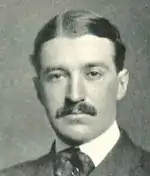 | |
| Born | June 16, 1872 Beacon Hill, Boston, Massachusetts, U.S. |
| Died | March 29, 1930 (aged 57)[1] New York City, U.S. |
| Resting place | Forest Hills Cemetery, Jamaica Plain, Massachusetts, U.S. |
| Other names | RGS II |
| Occupation | landowner, socialite |
| Spouse(s) | Mary Hannington
( |
| Children | Robert Gould Shaw III Louis Agassiz Shaw II |
| Parent(s) | Quincy Adams Shaw Pauline Agassiz |
Born in 1872 into one of the wealthiest and most influential families in Boston, he was a first cousin of Robert Gould Shaw (called RGS). As an adult, RGS II gained a reputation for alcohol abuse and promiscuity. His first wife was Nancy Witcher Langhorne, and they had a son, Robert Gould Shaw III (called RGS III or "Bobby"). RGS II and Langhorne divorced after four years of marriage. She moved to England after some time, where she met and married Waldorf Astor, who later succeeded his father as Viscount.
RGS II married again and had another son, Louis Agassiz Shaw II. Both of his sons suffered from depression, alcoholism, and legal difficulties. Bobby was arrested in England for homosexuality; he eventually committed suicide in 1970. Louis Agassiz Shaw II murdered his 60-year-old maid in 1964; was adjudged unfit for trial and was remanded instead to a psychiatric hospital, where he resided for nearly the rest of his life.[3]
Early life
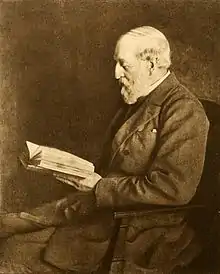
RGS II was the youngest child of Quincy Adams Shaw and Pauline (née Agassiz) Shaw. Quincy was one of the wealthiest men in Massachusetts as a result of his investment in the Calumet and Hecla Mining Company. RGS II's four older siblings were Louis, Pauline, Marian, and Quincy Jr.[4]
His father's side of the family had Anglo-American roots extending back to passengers on the Mayflower. His paternal grandparents were Robert Gould Shaw and Elizabeth Willard (née Parkman) Shaw. His maternal grandfather, Louis Agassiz, was a prominent paleontologist, glaciologist, geologist, and scholar of the Earth's natural history who immigrated from Switzerland in 1846.[5]
Among his large and prominent family was granduncle George Parkman (who was killed by John White Webster in a highly publicized case), first cousin (once removed) Francis Parkman, Jr. (a noted American historian and author of The Oregon Trail: Sketches of Prairie and Rocky-Mountain Life),[4][6] uncle Alexander Emanuel Agassiz (who served as president of Calumet and Hecla Mining Company and president of the National Academy of Sciences), cousin Rodolphe Louis Agassiz (a ten goal polo champion),[7] cousin Josephine Shaw (who married to Brig. Gen. Charles Russell Lowell III), and nephew Louis Agassiz Shaw, Jr. (who was a professor of physiology at Harvard Medical School and co-inventor of the first widely used iron lung).[8][9][10][11]
Personal life
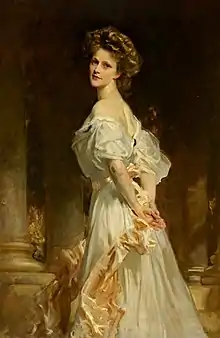
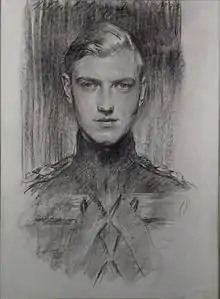
On October 27, 1897, RGS II married Nancy Witcher Langhorne (1879—1964) in New York City. She was the 18-year-old daughter of railroad millionaire Chiswell Dabney Langhorne and Nancy Witcher Keene. They had one son:[12]
- Robert Gould Shaw III (1898–1970).[13]
The marriage was unhappy for both and Shaw's friends accused her of being puritanical and rigid, while Nancy's friends contended that he was an alcoholic[14] and a womanizer.[15] Nancy left Shaw numerous times during their brief marriage, the first time during their honeymoon. In 1903, Nancy's mother died and she divorced him,[1][16] returning to Mirador, her childhood home.[17] After his ex-wife and son moved to England, Shaw had a limited role in his son Bobby's life.[15]
In 1905, while a passenger on a trans-Atlantic ship to England, the recently divorced Nancy met Waldorf Astor, eldest son of William Waldorf Astor and Mary Dahlgren Paul of the Astor family. The couple were married in May 1906, settling in Cliveden, a present from his father and the Astor family estate in Taplow, Buckinghamshire, England.[18] In 1919, Nancy ran for Parliament and won, becoming the first woman to sit as a Member of Parliament in the House of Commons.[19]
Second marriage
Shaw was married to Mary Hannington (1874–1937) and they had four sons:[20][12]
- Gould Shaw
- George Alexander Shaw
- Louis Agassiz Shaw II (1906–1987)[21]
- Paul Agassiz Shaw (1912–1983)
Shaw purchased a tract of land in Oak Hill, Newton, shortly after the death of its owner, William Sumner Appleton in 1903 (father of William Sumner Appleton, Jr.). He commissioned Boston architect James Lovell Little, Jr. to design and construct several buildings on the property, including outbuildings of a carriage house and horse stable in 1910,[22] a cow barn in 1912,[23] and a primary residence (the Appleton/Shaw House) in 1912.[24] As the Gilded Age gave way to the Progressive Era and eventually the Great Depression, the Shaw fortune collapsed.[25]
Shaw died at the Plaza Hotel after a brief illness in 1930.[12]
Legacy
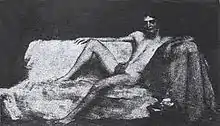
The vacant and decaying Shaw estate in Newton was sold in 1939 to Dr. William Fitts Carlson. Carlson used the property as the new campus for Mount Ida Junior College. Adjoining tracts of land were converted into the Wells Avenue office park in the 1970s, and the Charles River Footpath (since renamed the Helen Heyn Riverway) in the 1990s.[26]
In popular culture
Artist R. G. Harper Pennington in one of his paintings depicted a nude RGS II as the character "Little Billee" from the bohemian novel Trilby (1894) by George du Maurier. This painting hung in the bedroom of Henry Symes Lehr, the homosexual husband of Elizabeth Wharton Drexel.[27]
In a 1982 episode of Masterpiece Theatre that chronicled the life of Nancy Astor, Pierce Brosnan portrayed RGS II as a profligate and promiscuous gambler. In this version, Nancy Langhorne Astor continued to love RGS II after her marriage to Waldorf Astor, but this has not been documented. For this performance, Brosnan was nominated for a Best Supporting Actor in 1985.[28]
References
- G.E. Cokayne; Vicary Gibbs; H.A. Doubleday; Geoffrey H. White; Duncan Warrand; Lord Howard de Walden, eds. (2000). The Complete Peerage of England, Scotland, Ireland, Great Britain and the United Kingdom, Extant, Extinct or Dormant. Volume XIII:Peers created 1901 to 1938. Gloucester, United Kingdom: Alan Sutton Publishing. pp. 215–6.
- Biographical History of Massachusetts, Eliot, Vol. IX
- Beam, Alex (2001). "Chapter 9: Staying on: the elders from planet Upham". Gracefully Insane: Life and Death Inside America's Premier Mental Hospital. New York: Public Affairs. pp. 169–90. ISBN 978-1-58648-161-2.
- Boston Museum of Fine Arts (1918). "Introduction". Quincy Adams Shaw Collection (Italian Renaissance sculpture. Paintings and pastels by Jean François Millet. Boston: Museum of Fine Arts. pp. 1–4.
- New York Times (November 9, 1882). "An old abolitionist dead: Francis George Shaw and his services in the cause of freedom" (PDF). New York Times. Retrieved 2011-07-03.
- Parkman, Francis (1849). "Chapter I:The Frontier". The California and Oregon Trail: Being Sketches of Prairie and Rocky Mountain Life. New York: George P. Putnam. pp. 9–18.
- "R. L. Agassiz Dead. Mining Financier. Chairman of Board of Calumet and Hecla and Director of Many Corporations. Famous As Polo Player. More Recently Active, as Hunter and Fisherman Broke With Republican Party in 1928". New York Times. August 1, 1933. Retrieved 2014-12-20.
Louis Agassiz, chairman of the board of the Calumet and Hecla Consolidated Copper Company, director in many banks and corporations and a famous polo player ...
- Sherwood, RJ (1973). "Obituaries: Philip Drinker 1894 – 1972". The Annals of Occupational Hygiene. 16 (1): 93–4. doi:10.1093/annhyg/16.1.93. Retrieved 2011-07-02.
- Gorham, J (1979). "A medical triumph: the iron lung". Respiratory Therapy. 9 (1): 71–3. PMID 10297356.
- The Harvard Education and Research Center for Occupational Safety and Health (2010). "2010-2011 Student Handbook" (PDF). Cambridge, Massachusetts: The Harvard Education and Research Center for Occupational Safety and Health. Retrieved 2011-07-02.
- P.C. Rossin College of Engineering and Applied Science (2011). "Philip Drinker '17". Distinguished Alumni: Great Talents & Bright Minds. Bethlehem, Pennsylvania: Lehigh University. Archived from the original on 2011-06-15. Retrieved 2011-07-02.
- "ROBERT G. SHAW 2D DIES HERE AT 59; First Husband of Lady Astor Succumbs to Pneumonia at the Plaza. NOTED AS A SPORTSMAN Distinguished Himself as Poloist-- Became ill on His Arrival in City on Wednesday". The New York Times. 30 March 1930. Retrieved 29 June 2020.
- The Canterbury Auction Galleries (February 22, 2011). "February Sale Report: John Singer Sargent drawing sells for £23,000". News. Canterbury, Kent, England: The Canterbury Auction Galleries. Retrieved 2011-07-03.
- Sykes, Christopher (1972). "Chapter 4: Early sorrow". Nancy: The Life of Lady Astor. New York: Harper & Row. pp. 52–65. ISBN 9780002114851.
- Marlowe, Derek (1982). Nancy Astor: The Lady from Virginia. London: Weidenfeld & Nicolson.
- Lundy, Darryl (August 11, 2004). "Robert Gould Shaw II". ThePeerage.com. Wellington, New Zealand. Retrieved 2011-07-03.
- Prats, JJ (August 2, 2009). "Mirador". The Historical Marker Database. Retrieved 2011-07-03.
- Sykes, Christopher (1972). "Chapter 5: Love and marriage". Nancy: The Life of Lady Astor. New York: Harper & Row. pp. 66–88. ISBN 9780002114851.
- Haverty, Anne (1988). Constance Markievicz: an independent life. London: Pandora. p. 187. ISBN 978-0-86358-161-8.
- Biographical History of Massachusetts, Eliot, Vol. IX.
- "Massachusetts Man Seized in Strangling Of Maid on Estate". The New York Times. 9 April 1964. Retrieved 29 June 2020.
- Council of Independent Colleges (2006). "Holbrook Hall". Council of Independent Colleges Historic Campus Architecture Project. Washington, DC: Council of Independent Colleges. Retrieved 2011-07-03.
- Council of Independent Colleges (2006). "Hallden Academic Support Center". Council of Independent Colleges Historic Campus Architecture Project. Washington, DC: Council of Independent Colleges. Retrieved 2011-07-03.
- Council of Independent Colleges (2006). "Shaw Hall". Council of Independent Colleges Historic Campus Architecture Project. Washington, DC: Council of Independent Colleges. Retrieved 2011-07-03.
- Shaw, Colin Gould (December 2005). "Robert Gould Shaw II". Newton, Massachusetts: Newton Conservators Inc. Retrieved 2011-07-03.
- Newton Conservators (2011). "Newton Park and Conservation Lands: Helen Heyn Riverway". Newton Park and Conservation Areas. Newton, Massachusetts: Newton Conservators Inc. Retrieved 2011-07-03.
- Decies, Elizabeth Wharton Drexel Beresford (1935). King Lehr and the gilded age (The leisure class in America). Philadelphia, London: J.B. Lippincott Company. ISBN 978-0-405-06918-5.
- IMDb.com (2011). "Awards for Pierce Brosnan". Pierce Brosnan. Internet Movie Database. Retrieved 2011-07-03.
External links
- City of Newton Massachusetts Atlas (1886): Section V, Ward 5. The location of the tract of land purchased by Robert Gould Shaw II in 1903 (property owned by William Sumner Appleton) is clearly visible on this 1886 map of Newton, Massachusetts.
- Snoots, Jen (November 25, 2007). "Robert Gould Shaw, II (Memorial# 23098611)". Find a Grave. Salt Lake City, Utah. Retrieved 2011-07-03.
- IMDb.com (2011). "Full cast and crew for "Masterpiece Theatre: Nancy Astor"". Masterpiece Theatre: Nancy Astor. Internet Movie Database. Retrieved 2011-07-03.
- IMDb.com (2011). "Awards for Pierce Brosnan". Pierce Brosnan. Internet Movie Database. Retrieved 2011-07-03.
